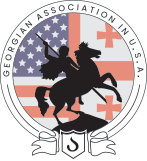The first Georgians who came to the United States were a group of 15 horse riders invited to join Buffalo Bill Cody and his Wild West Congress of Rough Riders of the World, which from the 1890s on, toured the United States and Europe for over 30 years. The Ringling Brothers Circus, one of the largest at the time, signed up approximately 30 more Georgian horse riders after 1900. A small number of Georgians wishing to escape military service during the 1904-5 Russo-Japanese war, and attracted by railway construction jobs in California trickled into the United States in the decade before World War 1. During the period of Georgian independence (1918-21), political links were established with the United States which had consular representation in Batumi and Tbilisi.
After the Red Army invasion of Georgia in 1921, many Georgians fled to Europe (most notably France and Poland). In the 1920s, approximately 150 of these exiles, mostly former officers, government officials and the scions of Georgian noble families came to the United States. They were members of Georgian princely families such as the Eristavis, Dadianis and Chavchavadzes (Prince Paul Chavchavadze, for example, was married to the niece of Tsar Nicolas II, and Prince Archil Gurieli to Helena Rubenstein, a famous perfumier). George Machabeli, the founder of the Machabeli perfume group, came to the US at this time, as did Alexander Kartvelishvili (Kartveli), an aeronautical engineer who helped establish Republic Aviation, an airplane design company which created the Thunderbolt plane. This small Georgian community was concentrated in New York City. They were the founders of the Georgian Association in the USA.
A significant wave of Georgians came after World War 11. Settled under the terms of the Displaced Persons Act of 1948 and the Refugee Relief Act of 1953, most were former prisoners of war or displaced European citizens. A number had been members of the National Committee for the Liberation of Georgia, or members of the Georgian Legion that fought on the German side in the war, hoping to liberate Georgia from Soviet occupation. A few fled the newly Sovietized Polish state, and others came after serving in the French Foreign Legion. Giorgi Papashvili described his experiences as a new Georgian immigrant in the book Anything Can Happen, published in 1945. There are other unpublished Georgian memoir materials which indicate many new Georgian immigrants had a hard time in these early post-war years, although charitable organizations such as the Tolstoy Foundation and the Church World Service helped new Georgian-Americans them find employment.
In the 1970s, Georgian Jews, benefiting from the policies of “detente” between the superpowers, began to find their way to the United States, with the first 10 families arriving in 1973-74. Two larger waves of Georgian Jews followed in 1978-80 and in the mid-1980s, many making their way from Israel. They were helped to settle by the Hebreww Immigrant Aid Society and the New York Association for New Americans. Most Georgian Jews in the United States currently live in the Queen’s district of New York City. They have built their own synagogue; many work in the jewellery trade ( New York’s 47th street) or in retail and restaurants.
Since 1991, the Georgian community in the USA has received a new infusion through the arrival of students and scholars on exchange programs, and through the presence of Georgian diplomats, artists, and businessmen in Washington D.C. and New York City. A Georgian embassy was established in Washington D.C in 1993). and there are Georgian consulates in San Francisco and NYC. Georgians have become more geographically scattered throughout the USA in the last two decades.
The first Georgian organization in the United States was the kartuli sazogadoeba (the Georgian Society) founded in San Francisco in 1924. In 1930 the Caucasian Society Alaverdi was formed to unite different Caucasian groups . In 1931 the kartuli sazogadoeba Amerikis sheertebul shtatebshi (the Georgian Association in the United States), was founded by, among others, Prince Giorgi Machabeli, Tsiko Eristavi, Paul Kvaratskhelia and Irakli Orbeliani. In the 1950s, many of the new immigrants became enthusiastic supporters of US anti-communist policies. More politicized than their predecessors, they formed a number of leagues and parties: the kartuli-Amerikuli liga (Georgian-American League), the kartuli erovnuli kavshiri (Georgian National Union) and sakartvelos damoukideblobis Amerikuli sabcho (American Council for Independent Georgia). The Georgian-American League published a newspaper, the Voice of Free Georgia, from 1953-58, and the American Council for Independent Georgia published chveni gza (Our Path) in 1953. Between 1955-75, the broader and less politicized community was served by the newspaper kartuli azri (Georgian Opinion). In 1951, Georgians were awarded their own radio section on Voice of America which functions today.

